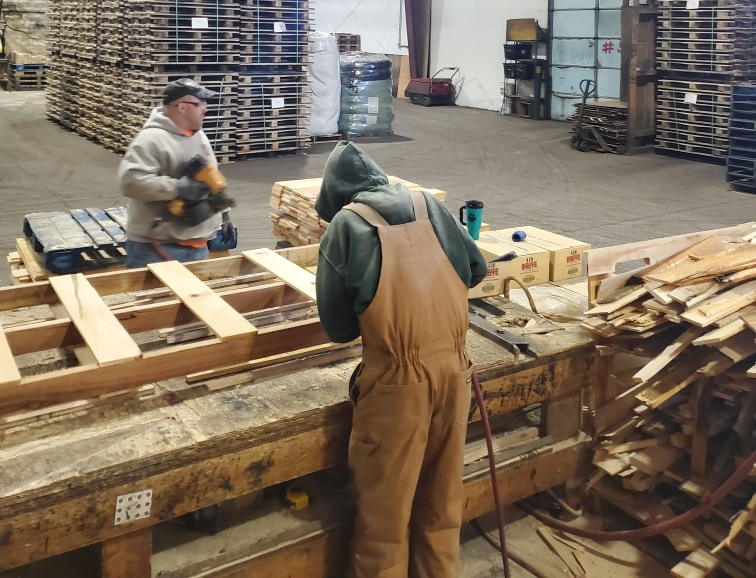In the realm of logistics, the pallets stands as an unrecognized champion, changing the way goods are delivered and kept. pallets in tulsa yet ingenious platforms have evolved over the years, adapting to the dynamic demands of sectors across the globe. From their early days as simple wooden structures to the complex designs we see today, pallets have become essential in improving both transportation and storage processes.
Timber pallets, in specifics, have secured a significant place in this evolution. Their intrinsic strength, durability, and ease of maintenance make them a preferred choice for enterprises looking to move products efficiently and safely. As organizations strive to optimize operations and reduce costs, the value of pallets in facilitating smooth supply chains cannot be underestimated. This article will explore the evolution of the pallet, analyzing its development and the essential role it plays in the current supply chain.
Chronological Development of Wooden Platforms
The use of wood skids can be traced to the first 20th century when they emerged as a viable answer for the movement of goods. Before skids became commonplace, individual items were frequently handled and transported separately, making supply chains inefficient. The introduction of skids revolutionized the shipping industry by allowing various items to be grouped together, resulting in shortened handling times and improved protection during transport.
As economic development advanced, the requirement for more optimized transportation methods increased. Timber skids became standardized during WWII, as they were essential for transporting substantial amounts of supplies and equipment. The armed forces recognized the advantages of pallets in simplifying loading operations, which aided their broad integration across different sectors in the decades that came. This normalization also resulted in the design of various pallet forms and dimensions to accommodate a range of merchandise and distribution systems.
By the end 20th century, wood platforms had established their position as a key component in logistics management. Advancements such as improved drying techniques and finishing techniques boosted the strength and lifespan of wood skids. As businesses stretched globally, the demand for trusted and effective logistics methods made wooden pallets a staple in storage facilities around the globe, continuing to enhance inventory and distribution for countless fields.
Effect on Supply Chain Effectiveness
Timber pallets have significantly revolutionized the way goods are shipped and stored, resulting in enhanced efficiency throughout the supply chain. Their uniform size allows for maximum utilization of room in transport vehicles, storage facilities, and shipping containers, enabling businesses to optimize their logistics processes. This uniformity simplifies loading and unloading tasks, reducing the time required for managing goods and lowering overall labor costs.
Furthermore, the durability of wooden pallets guarantees that they can hold up under heavy loads without compromising stability. This reliability reduces the risk of harm to products during shipping, which is essential for maintaining quality and minimizing losses. As companies focus on just-in-time inventory practices, the ability to keep products intact and readily available specifically contributes to fulfilling customer needs and enhancing service quality.
In addition to their utility, wooden pallets are also environmentally friendly, as they can be refurbished and reused. This green aspect of their use fits well with the growing emphasis on reducing carbon footprints within supply chains. By utilizing wooden pallets, businesses not only improve operational efficiency but also demonstrate a dedication to responsible practices that appeal with eco-conscious consumers.
Sustainability and Innovations in Wooden Pallet Creation
As the need for sustainable practices continues to grow, wooden pallets have made significant strides in minimizing their environmental impact. Many producers are now obtaining wood from certified sustainable forests, ensuring that their pallets contribute positively to the ecosystem. Additionally, advancements in wood treatment processes have reduced the reliance on toxic chemicals, making pallets safer for both the planet and the products they carry. Companies are increasingly prioritizing sustainability, recognizing that consumers are more likely to favor brands that demonstrate environmental responsibility.

In response to the need for enhanced durability and longevity, the construction of wooden pallets has evolved. New construction techniques, such as the use of interlocking designs and optimized compression strength, have led to pallets that can withstand heavier loads and more rigorous handling. This not only boosts performance but also prolongs the lifecycle of the pallets, reducing the frequency of replacements and waste. Such advancements ensure that wooden pallets remain a trustworthy choice for logistics and storage solutions.
The future of pallet creation also embraces technology, with the integration of intelligent features like RFID tags for tracing and inventory management. This progress provides businesses with real-time data, enhancing supply chain efficiency and lowering losses associated with lost or damaged pallets. By combining traditional wooden materials with modern technology, the industry is poised to address the evolving demands of logistics while upholding a commitment to sustainability.
